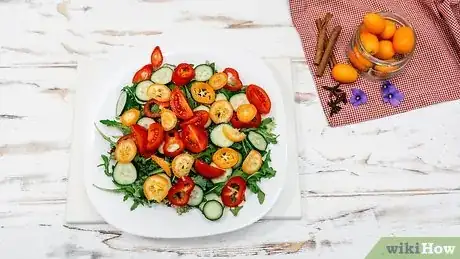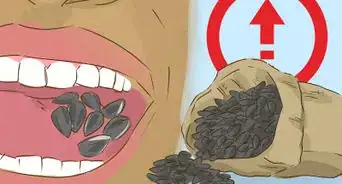wikiHow is a “wiki,” similar to Wikipedia, which means that many of our articles are co-written by multiple authors. To create this article, 27 people, some anonymous, worked to edit and improve it over time.
There are 8 references cited in this article, which can be found at the bottom of the page.
wikiHow marks an article as reader-approved once it receives enough positive feedback. This article received 21 testimonials and 100% of readers who voted found it helpful, earning it our reader-approved status.
This article has been viewed 764,273 times.
Learn more...
Kumquats look like miniature, usually oval oranges. They have a sour, citrus tang, and can even cross-breed with citrus fruit, but are sometimes classified as a separate genus.[1] Strangest of all, the peel of the kumquat is sweet and delicious, creating a surprising clash of flavor when the fruit is eaten whole.
Steps
Eating a Kumquat
-
1Choose ripe kumquats. Ripe kumquats range from bright orange to yellow-orange. Stay away from greenish, unripe fruits. The skin should be nice and firm, free of blemishes or shriveled areas.[2]
-
2Wash and dry the fruit. No matter where you got the kumquat, rub the peel under cool, running water. Since the peel is edible, you don't want any traces of pesticides or dirt on the surface. Pat the fruit dry with a paper towel.Advertisement
-
3Rub the kumquat (optional). Some say that rubbing or squeezing the fruit between your fingers helps it release the sweet, citrus-like scent of the rind.[3]
-
4Remove the seeds (optional). The seeds are not poisonous, but they have the same bitter taste as orange seeds. If you're feeling dainty, slice the kumquat in half and pluck out the seeds. You can easily spit the seeds out as you eat instead, or even chew them up if you don't mind the flavor.
- Pull off the nubs of green stems as well.
-
5Eat the kumquat. Unusually, kumquats have a sweet rind and sour flesh. Nibble the end of the kumquat to taste the rind first. Once you encounter the mouth-puckering juice, you can either keep nibbling cautiously or pop the whole fruit in your mouth. If you can stand it, the explosive wedding ceremony between tart and sweet is unique in the fruit world.
- Some kumquat species are less sour than others or have a thicker peel. If the flavor doesn't impress you, try to find a different type, or use the fruits in cooking.
- If you hate the sour taste, squeeze out the juice and eat the peel by itself.
-
6Store extra kumquats. Kumquats will last for about two days at room temperature, or about two weeks in an airtight, refrigerated container.[4] You can eat them cold from the fridge or let them warm up first, whichever you prefer.
Cooking with Kumquat
-
1Slice and add to salads. Their intense flavor makes kumquat a good pairing for bitter or peppery greens, such as endive or arugula. Slice into thin rounds with a sharp knife. Remove the seeds, then layer the slices on top of the salad to show off the color.
-
2Make kumquat marmalade. Kumquat marmalade is much sweeter and less bitter than regular marmalade. The recipe is similar to most marmalades or jams.
- Since the kumquat seeds contain pectin, you can boil them along with the fruit to thicken your preserves. Keep the seeds in a cheesecloth bag while boiling, so they don't end up in your jar.[5]
-
3Pickle the kumquats. Pickling takes at least three days, but the result is quite unique. This particular recipe keeps some of the kumquat's sweet flavor.
-
4Add the kumquat to meat dishes. The acidic kumquat adds a nice flavor to lamb and poultry dishes. Add it 30 minutes before the meat is done braising or simmering.[6] Seafood pairs especially well with kumquat, but it doesn't need to marinate in it. Add the fruit at the last minute instead, either as a garnish or blended in a vinaigrette.
-
5Infuse vodka with kumquat flavor. Wash plenty of kumquats and cut them in half — at least 10 fruits per cup (240mL) of vodka.[7] Cover with vodka and let sit in a cool, dark place, shaking once a day. It should pick up a faint taste after a couple of days, a strong taste after a week or two, and steadily continue to infuse for many weeks or months.
- If you enjoy sweet liquor, add some sugar as well, up to ¼ cup (25g) sugar per cup (240mL) of vodka.[8]
-
6Stew kumquats. In the United States, the first appearance of kumquats coincides with Thanksgiving preparations. Take advantage of this to add pizazz to your holiday cranberry sauce, or use the same basic approach to make chutneys and desserts:
- Slice 1½ cups (360mL) kumquats. Discard the seeds and stem.
- Simmer in a covered saucepan with ¼ cup (60mL) water, until the kumquats soften.
- Add one of the following:
- A can of cranberry sauce
- Or dried cherries, grated ginger, black pepper, and cinnamon[9]
- Or ¾ to 1 cup (150–200g) sugar to make candied kumquats
- Simmer uncovered for 10–15 minutes, until chutneys become a little translucent. Add more water whenever the pan starts to look dry.
-
7Freeze the rinds into cups. Cut large kumquats in half horizontally. Scoop out the sour, juicy flesh with a narrow teaspoon or grapefruit spoon, and add it to smoothies, fruit salad or ice cream. Freeze the hollow rinds in airtight containers, then use the rinds to hold sorbet or other desserts.
- Alternatively, leave the flesh in the cut kumquats. Dip the ends in a beaten mix of egg white and honey, then in a mixture of raw sugar and cinnamon. Freeze and eat as a fancy dessert.[10]
-
8Finished.
-
9Finished.
Community Q&A
Did you know you can get answers researched by wikiHow Staff?
Unlock staff-researched answers by supporting wikiHow
-
QuestionAre you supposed to eat the skin of kumquats?
 wikiHow Staff EditorThis answer was written by one of our trained team of researchers who validated it for accuracy and comprehensiveness.
wikiHow Staff EditorThis answer was written by one of our trained team of researchers who validated it for accuracy and comprehensiveness.
Staff Answer wikiHow Staff EditorStaff Answer
wikiHow Staff EditorStaff Answer -
QuestionAre loquats the same as kumquats?
 wikiHow Staff EditorThis answer was written by one of our trained team of researchers who validated it for accuracy and comprehensiveness.
wikiHow Staff EditorThis answer was written by one of our trained team of researchers who validated it for accuracy and comprehensiveness.
Staff Answer wikiHow Staff EditorStaff Answer
wikiHow Staff EditorStaff Answer -
QuestionCan I swallow the whole thing?
 Community AnswerYes, the entire fruit is edible. I'd suggest chewing the fruit, though, instead of swallowing it whole.
Community AnswerYes, the entire fruit is edible. I'd suggest chewing the fruit, though, instead of swallowing it whole.
Things You'll Need
- Knife (optional)
- Water to wash the kumquat
- A kumquat
- Sugar (optional)
References
- ↑ https://www.hort.purdue.edu/newcrop/morton/kumquat.html
- ↑ http://www.npr.org/templates/story/story.php?storyId=18828304
- ↑ http://www.nutrition-and-you.com/kumquat-fruit.html
- ↑ http://www.npr.org/templates/story/story.php?storyId=18828304
- ↑ http://www.growingagreenerworld.com/kumquat-marmalade-and-canning-tips/
- ↑ http://www.nytimes.com/2006/02/26/magazine/26food.html
- ↑ http://mymansbelly.com/2011/06/17/infused-vodka-recipes-the-kumquat-summer-tease/
- ↑ http://www.withaglass.com/?p=8902
- ↑ http://www.npr.org/templates/story/story.php?storyId=18828304
About This Article
If you've never tried a kumquat before, leave the skin on the fruit, and rinse it under cool, running water to remove any dirt. Then, try biting into the kumquat or slicing it in half to remove the seeds before you begin eating. The flesh of the kumquat is sour, and the rind is sweet! Alternatively, if you don't want to eat them whole, you can use kumquats in a salad or make them into a marmalade. For tips on incorporating kumquats into a recipe, read on!



























































